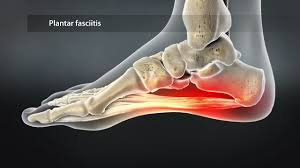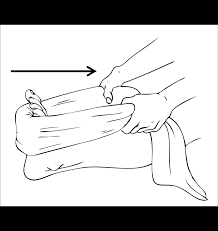|
 Plantar fasciitis is a common condition characterized by pain in the heel and bottom of the foot, often due to inflammation of the plantar fascia. It can significantly impact daily activities and athletic performance. Fortunately, certain exercises can help alleviate symptoms, strengthen the foot, and promote healing. Here are ten effective exercises for plantar fasciitis, complete with descriptions and benefits. Plantar fasciitis is a common condition characterized by pain in the heel and bottom of the foot, often due to inflammation of the plantar fascia. It can significantly impact daily activities and athletic performance. Fortunately, certain exercises can help alleviate symptoms, strengthen the foot, and promote healing. Here are ten effective exercises for plantar fasciitis, complete with descriptions and benefits.
1. Calf Stretch
How to Do It:
Stand facing a wall with your hands pressed against it.
Step one foot back, keeping it straight and your heel on the ground.
Bend your front knee and lean forward until you feel a stretch in the calf of the back leg.
Hold for 15-30 seconds, then switch legs.
Benefits: Stretching the calf muscles helps alleviate tension in the Achilles tendon and plantar fascia, promoting overall flexibility.
2. Plantar Fascia Stretch
How to Do It:
Sit on a chair and cross one foot over the opposite knee.
Grasp your toes and gently pull them back towards your shin.
You should feel a stretch along the bottom of your foot.
Hold for 15-30 seconds and switch feet.
Benefits: This stretch targets the plantar fascia directly, providing relief and improving flexibility.
3. Towel Stretch
 How to Do It: How to Do It:
Sit on the floor with your legs stretched out in front of you.
Take a towel and loop it around the ball of one foot.
Gently pull the towel towards you while keeping your knee straight.
Hold for 15-30 seconds, then switch feet.
Benefits: This exercise stretches both the calf muscles and the plantar fascia, promoting healing and reducing stiffness.
4. Toe Taps
How to Do It:
Sit or stand comfortably with your feet flat on the floor.
Lift your toes while keeping your heels on the ground.
Tap your toes down and lift them again.
Repeat for 10-15 repetitions.
Benefits: Toe taps strengthen the intrinsic muscles of the foot, improving stability and supporting the arch.
5. Foot Rolling
How to Do It:
Sit in a chair and place a tennis ball or a frozen water bottle under your foot.
Roll the ball or bottle back and forth along the arch of your foot.
Apply as much pressure as comfortable and roll for 5-10 minutes.
Benefits: This exercise helps relieve tension in the plantar fascia and provides a soothing massage effect.
6. Heel Raises
How to Do It:
Stand with your feet shoulder-width apart and your weight evenly distributed.
Slowly rise up onto your toes, lifting your heels off the ground.
Hold for a moment at the top, then lower back down.
Repeat for 10-15 repetitions.
Benefits: Heel raises strengthen the calf muscles and improve overall foot stability, reducing the risk of future injuries.
7. Arch Lifts
How to Do It:
Stand with your feet flat on the ground.
Slowly lift the arch of one foot while keeping your toes and heel on the floor.
Hold for a few seconds, then relax.
Repeat 10-15 times on each foot.
Benefits: This exercise targets the muscles that support the arch, promoting strength and stability.
8. Seated Foot Stretch
How to Do It:
Sit on a chair with your feet flat on the floor.
Extend one leg and flex your foot, pulling your toes toward you.
Hold for 15-30 seconds and switch legs.
Benefits: This stretch helps relieve tension in the foot and calf, enhancing flexibility and range of motion.
9. Resistance Band Foot Flexion
How to Do It:
Sit on the floor with your legs stretched out in front of you.
Loop a resistance band around the ball of one foot and hold the ends.
Pull the band towards you while keeping your foot flexed.
Hold for 15-30 seconds, then switch feet.
Benefits: This exercise strengthens the muscles in the foot and ankle while promoting flexibility.
10. Balance Exercises
How to Do It:
Stand on one foot for 15-30 seconds, using a chair or wall for support if needed.
Progress by closing your eyes or standing on an unstable surface (like a cushion).
Repeat on each foot.
Benefits: Balance exercises improve stability and proprioception, helping to prevent further injuries.
Creating a Routine
To effectively manage plantar fasciitis, consider incorporating these exercises into a daily routine:
Warm-Up: Start with gentle movements like ankle circles or foot rolls to get blood flowing.
Stretching: Incorporate calf and plantar fascia stretches before and after any activity.
Strengthening: Focus on exercises like heel raises and arch lifts to build muscle strength.
Balance Training: Include balance exercises to enhance stability and prevent future issues.
Cool Down: Finish with gentle stretching and foot rolling for relaxation.
Frequency and Progression
Frequency: Aim to perform these exercises at least 5 times a week.
Duration: Hold stretches for 15-30 seconds and repeat each exercise for 10-15 repetitions.
Listen to Your Body: If any exercise causes pain, reduce intensity or consult a healthcare professional.
Additional Considerations
Footwear: Wearing supportive shoes with proper arch support can significantly enhance recovery.
Rest and Ice: Allow time for rest and apply ice to reduce inflammation after activities.
Consult a Professional: If symptoms persist, consult a healthcare provider or physical therapist for personalized guidance.
Plantar fasciitis can be a frustrating condition, but with the right exercises, it is manageable. Incorporating these ten exercises into your routine can help alleviate pain, strengthen the foot, and promote healing. Consistency is key, and combining these exercises with proper footwear and self-care strategies will yield the best results.
Always consult with a healthcare professional before starting a new exercise regimen, especially if you have existing foot or health issues.
|